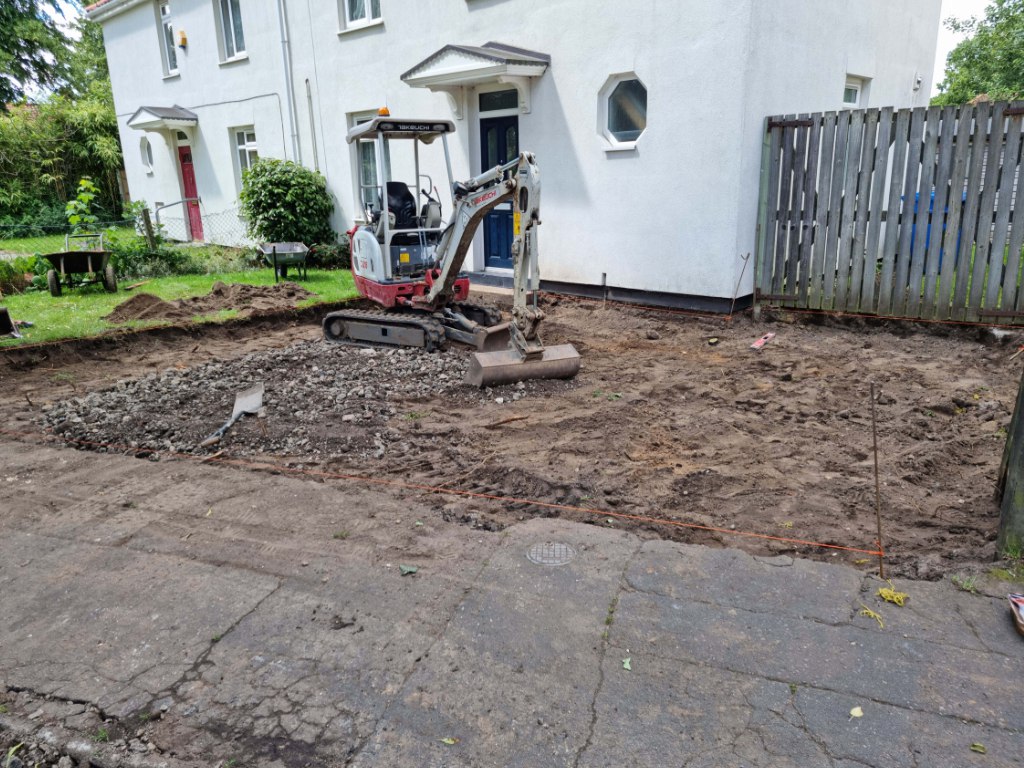What’s the Difference Between Tarmac and Asphalt?
When it comes to surfacing driveways, car parks, and roads, two materials are often mentioned interchangeably — tarmac and asphalt. While they may look similar to the untrained eye, there are key differences between the two that affect performance, durability, and suitability for specific projects.
At NS Driveways Redhill, we’re often asked which surface is best for residential and commercial driveways in Redhill and the wider Surrey area. Understanding how tarmac and asphalt differ can help you make an informed decision and ensure your driveway delivers the longevity, finish, and performance you expect.
What Is Tarmac?
Tarmac, short for tarmacadam, was one of the earliest forms of road surfacing. It was originally developed in the early 1900s by combining crushed stone with tar, which acted as a binding agent to hold the materials together.
Modern tarmac uses bitumen instead of natural tar — a by-product of the petroleum refining process. The mixture of crushed aggregate and bitumen creates a durable, flexible surface suitable for a range of applications, including driveways, footpaths, and car parks.
Key Characteristics of Tarmac:
- Flexible surface: Ideal for residential driveways that experience moderate traffic.
- Smooth and attractive finish: Offers a clean, uniform appearance suitable for modern homes.
- Quick to install: Can often be laid and set within a relatively short timeframe.
- Good resilience: Adapts well to the ground’s movement, reducing the risk of cracking.
Tarmac’s flexibility and smooth appearance make it a popular choice for homeowners across Redhill looking for a reliable, long-lasting surface.
What Is Asphalt?
Asphalt is a more advanced evolution of tarmac. It’s made using a refined process that combines bitumen with carefully graded aggregates, such as sand, gravel, and crushed stone, heated and mixed at high temperatures.
The result is a denser, more cohesive surface that provides superior strength, durability, and resistance to wear and tear. Asphalt is commonly used for high-traffic roads, car parks, and commercial driveways where a tougher surface is required.
Key Characteristics of Asphalt:
- High load-bearing strength: Ideal for driveways and roads that handle frequent or heavy vehicle use.
- Durable finish: Resistant to scuffing, deformation, and weathering.
- Low maintenance: Once installed, it requires minimal upkeep over time.
- Long lifespan: When properly laid, asphalt can last many years with little deterioration.
Because of its density and smoothness, asphalt is often chosen for areas that require a sleek, professional finish capable of withstanding consistent use.
The Key Differences Between Tarmac and Asphalt
Although both materials share some similarities — namely their dark, smooth appearance and use of bitumen as a binder — their composition and performance characteristics differ in a few important ways.
1. Composition and Texture
Tarmac combines bitumen and smaller aggregates, producing a slightly rougher texture. Asphalt, however, uses a precise blend of larger, graded aggregates that are heated during production. This results in a denser and smoother surface with fewer air gaps.
2. Strength and Durability
Asphalt’s tightly bonded structure makes it stronger and more resistant to cracking, rutting, and surface deformation, especially under heavy loads. Tarmac, while still robust, is slightly more flexible and better suited for areas with lighter traffic.
3. Weather Resistance
Both materials handle British weather well, but asphalt tends to have the edge in long-term performance. It copes better with temperature changes, meaning fewer cracks form from expansion and contraction. Tarmac, on the other hand, performs excellently in wet conditions due to its ability to shed water quickly when laid correctly.
4. Lifespan and Maintenance
Asphalt generally lasts longer than tarmac before requiring resurfacing. However, tarmac is easier to repair when damage does occur, as small areas can be patched or resurfaced without replacing the entire surface.
5. Visual Finish
Both tarmac and asphalt offer a dark, neat finish, but asphalt’s slightly glossier appearance can give driveways a more polished, refined look. Homeowners seeking a softer, more traditional finish often prefer tarmac, while those wanting a contemporary, professional appearance may lean toward asphalt.
Choosing the Right Surface for Your Property
When deciding between tarmac and asphalt for your driveway, consider how the area will be used and what kind of aesthetic you want to achieve.
Tarmac Is Best Suited For:
- Residential driveways and small car parks.
- Areas requiring a quick installation and smooth finish.
- Surfaces where flexibility and ease of repair are important.
Asphalt Is Ideal For:
- Larger driveways or commercial properties with heavier traffic.
- Long-term performance and minimal maintenance.
- A sleek, high-end look with added strength.
At NS Driveways Redhill, we assess each project individually, considering factors such as traffic levels, ground conditions, and desired appearance to recommend the most suitable surface type.
Why Both Materials Perform Exceptionally Well
Regardless of which you choose, both tarmac and asphalt provide robust, weather-resistant surfaces that enhance the appearance and functionality of your property. Their shared use of bitumen as a binder means both materials deliver durability, drainage efficiency, and adaptability — essential features for the unpredictable British climate.
When installed correctly by experienced professionals, both can last for many years with minimal maintenance, making them excellent investments for homeowners and businesses alike.
Professional Installation for Long-Lasting Results
The quality of installation plays a major role in how long any surfacing material lasts. A poorly prepared base or uneven application can lead to premature wear, cracks, or drainage issues.
At NS Driveways Redhill, we take great care in preparing the groundwork, applying the material evenly, and ensuring a strong, smooth finish. Our expert team combines traditional techniques with modern equipment to deliver driveways that are both practical and visually appealing.
Conclusion
Tarmac and asphalt are two of the most durable and reliable surfacing materials available today. While their differences lie in composition, strength, and finish, both provide excellent long-term performance when professionally installed.
For homeowners in Redhill and throughout Surrey, NS Driveways Redhill offers expert guidance and installation of both tarmac and asphalt driveways. Whether you’re looking for a traditional driveway surface or a modern, high-strength finish, our team can create a durable, attractive surface that enhances your property for years to come.
Call us on: 01737 302 099
Click here to find out more about NS Driveways Redhill
Click here to complete our contact form and see how we can help with your driveways.

